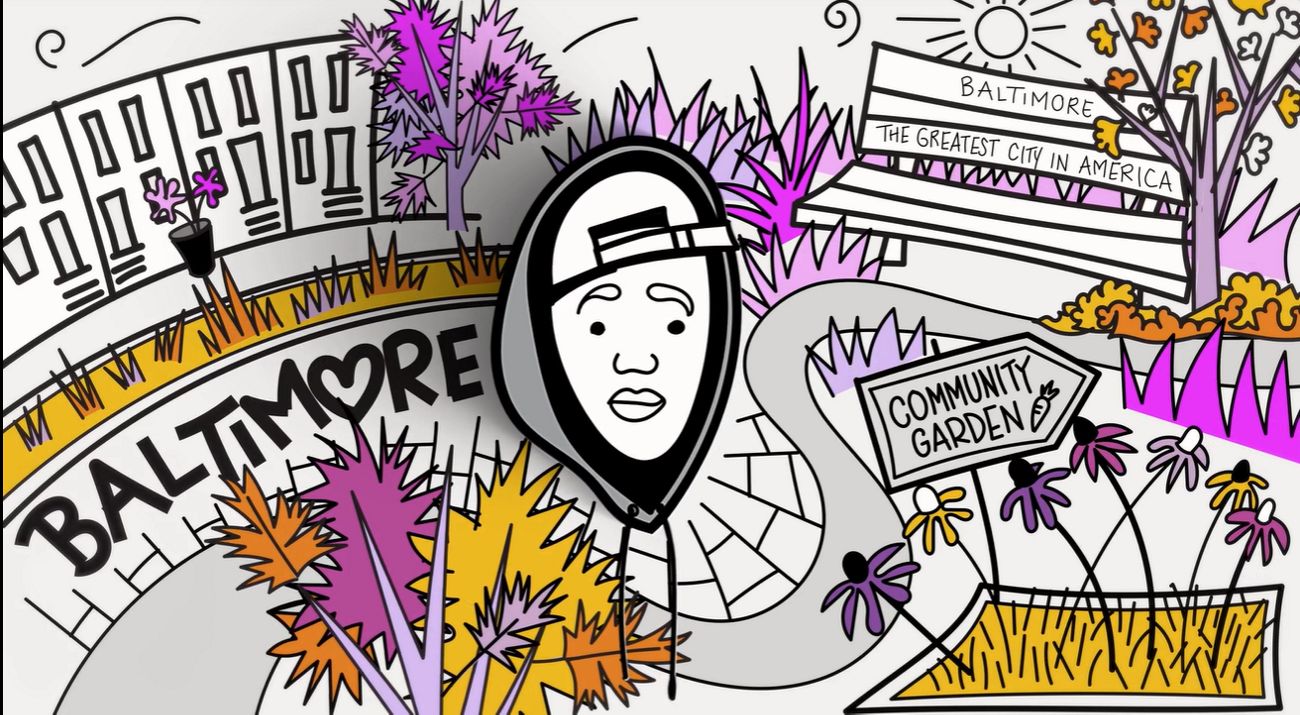
New animated short film ‘To The Jungles That Be’ highlights inequities in community access to nature through poetry and art
The film is part of a larger effort in Baltimore that aims to increase support for urban and community forestry through art and design.
Media Contacts
-
Matt Kane
Phone: 323-898-6510
Email: matthew.kane@tnc.org
In the new animated short film To The Jungles That Be, the work of Baltimore poet Kondwani Fidel and artist Saba Hamidi highlight how people experience nature differently depending on where they grow up and whether they have access to healthy natural environments. The film is being used to start conversations in urban and underserved communities to better understand their relationship to nature and their interest in participating in Maryland’s Tree Solutions Now Act, which aims to plant 5 million trees in the state by 2031 with 500,000 in urban and underserved communities. The film can be viewed on The Nature Conservancy’s Youtube channel or www.tothejungles.com, where users are also invited share their stories and experiences of nature.
Kondwani Fidel – “I agreed to participate in this project because I grew up in the city, where I loved playing around in and exploring nature, contrary to the popular belief among many inner-city kids. Being an adult and having the opportunity to share my voice on those childhood memories, while also exploring the racial barriers I had to endure to enjoy basic needs like clean air, trees, water, etc. was perfect. And I hope it can shed light on the good times and the obstacles we endured while being one with nature.”
Saba Hamidi - “As a visual storyteller, I'm often drawn to stories that need to be heard (and seen). When the opportunity was presented to work on a project that focused on telling one of Baltimore's many noteworthy stories, I knew right away that I wanted to be involved. As one of my more in-depth illustration projects, this particular one means so much to me because it's not only given me a chance to showcase the type of work I'm most passionate about, but it brought me together with a team of people that truly committed to putting their heart & soul into amplifying a voice that must be heard throughout Baltimore and, hopefully, beyond. I'm so proud to have been a part of this journey.”
To The Jungles That Be was directed by Dave Cooper of Dave Cooper Films, animated by Bronson Hoover of dnbstudios and executive-produced by Isaac Hametz, Director of the Baltimore Program of The Nature Conservancy. The interactive Tothejungles.com website was created by Noisy Tenants, a community-centered production agency based in Baltimore. Funding was provided by The Nature Conservancy’s Maryland and DC chapter.
Director Dave Cooper - “To The Jungles That Be is about listening to people whose personal experiences can offer us perspectives we cannot gain through academic study. It is an opportunity for those in positions of power and with resources, to face their failures and build a more sustainable, greener and healthier future for all of the citizens they serve.”
Executive Producer Isaac Hametz (TNC) – “We chose to use art to engage in a public dialogue about nature for people to see themselves in the story of climate action. For too long, narratives of nature have excluded black and brown communities, including communities like the one Kondwani grew up in. This has and continues to negatively impact our ability to respond to climate change. We need to do a better job of using tools like art and design to inspire people to participate in and shape the future of the world that they want to live in.”
The Nature Conservancy’s Baltimore program is collaborating with local partners to roll out To The Jungles That Be this summer with the goal of engaging Baltimore residents and learning about their experiences and priorities for nature and urban forestry. Input from residents collected during the summer events will be synthesized using social science methods to improve understanding of community urban forestry needs, perceptions and priorities, which TNC’s Baltimore program will use to shape culturally sensitive technical assistance such as landscape design and grant writing support to enhance outcomes of State’s Tree Solutions Now Act.
Dr. Michele Romolini of Loyola Marymount University’s Center for Urban Resilience will conduct the analysis adding “The pursuit of environmental justice in urban forestry is not just about getting more trees into communities. It’s also about centering the experiences, priorities and knowledge of the people who live there.”
Jaline McPherson, a landscape designer with TNC’s Baltimore program will facilitate the engagements and is excited to “learn from the conversations, shape a deeper collective understanding of diverse experiences about urban forestry in Baltimore and share participants’ visions with partners to foster a more equitable and resilient environment for all.”
The workshops will take place at a variety of events over the summer, including at the Farm Alliance of Baltimore’s Black Butterfly Teaching Farm Community Day on July 20th and a community event with Women of Color Outdoors on July 28th. The Nature Conservancy is also sponsoring a visual storytelling internship to document the project.
The Nature Conservancy is a global conservation organization dedicated to conserving the lands and waters on which all life depends. Guided by science, we create innovative, on-the-ground solutions to our world’s toughest challenges so that nature and people can thrive together. We are tackling climate change, conserving lands, waters and oceans at an unprecedented scale, providing food and water sustainably and helping make cities more resilient. The Nature Conservancy is working to make a lasting difference around the world in 83 countries and territories (39 by direct conservation impact and 44 through partners) through a collaborative approach that engages local communities, governments, the private sector, and other partners. To learn more, visit nature.org or follow @nature_press on X.